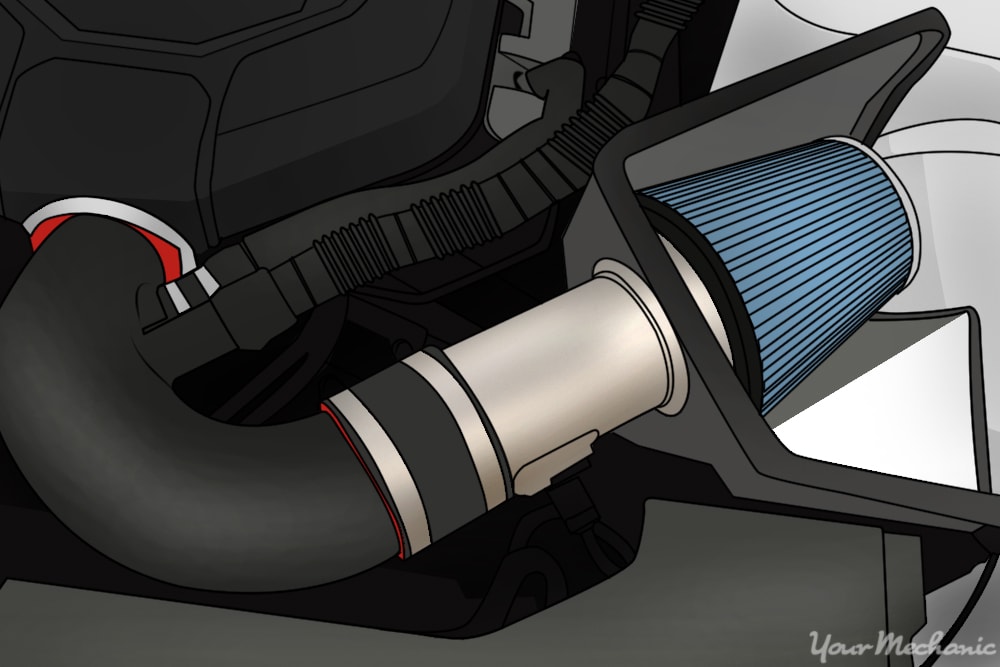

Adding a cold air intake system is a common aftermarket upgrade for many sport car enthusiasts in North America. These power-adders are designed by aftermarket manufacturers and designed to replicate a few of the benefits of nitrous oxide without the chemical addition. These performance air intakes are fairly inexpensive and are usually designed to fit specific engine designs, making it easy to find and choose a cold air intake for your car.
While they are rather simple to install, you should consider a few important items before making the investment. Noted below are some things to ask yourself before you decide to purchase a cold air intake, and tips for choosing one.
What is a Cold Air Intake?
If you’re reading this article, it’s likely you’re trying to learn more about cold air intakes before making the investment. A cold air intake is a bolt-on aftermarket replacement for the stock air intake system, which is designed to draw air from the outside, flow through an air filter, and into the throttle body of a fuel-injected engine to mix with gasoline or diesel fuel. This creates a vapor, which is injected into the cylinder heads and eventually into the combustion chamber to be burned. The cold air intake system doesn’t “make” air colder — it simply removes heat generated from the stock air intake due to its location.
How is a Cold Air Intake Different from the Standard System?
An aftermarket cold air intake system differs from the standard equipment your car comes with. Two of the changes from a standard air intake to a cold air intake system include:
- Changing the material of the air intake: Most stock or OEM air intakes are made of hard plastic with sheet metal for durability and longevity. However, these materials absorb heat rather easily, which increases the temperature of the air flowing into the throttle body to be vaporized. A cold air intake is usually made from aluminum or polymers that are less heat sensitive.
- Moving the air filter location:The location of the air filter also changes. The filter is made from a cotton-like material that itself is a conductor of heat. The stock filter is typically housed near the engine compartment— specifically on top of the cylinder intake manifold. The cold air intake moves the filter location towards the front of the car to remove heat for cooler air flow into the throttle body.
Why is Colder Air Important for Horsepower?
Let’s head back to chemistry class for a second. If you recall, heat causes air molecules to shrink. It also “eats” oxygen — which is why a fire will grow as more oxygen is available and shrinks or dies when oxygen is removed. Air that is colder has larger molecules and a higher concentration of oxygen. Since oxygen is a natural fuel source for burning, the more oxygen in your fuel vapor, the bigger the explosion inside the combustion chamber, and thus: more horsepower gain. The cold air intake helps improve power but also tends to consume more fuel, which is why fuel economy typically drops when it’s installed.
How Should You Choose a Cold Air Intake System?
Like any other aftermarket component, correct application is the most important item to consider. When selecting one for your car, examine these 5 factors:
1. Vehicle-specific design. Most cold air intake manufacturers design them to fit specific engine and vehicle types, years, makes, and models. The first thing you need to do is verify that the product you’re ordering and installing is recommended for your specific vehicle.
2. Material. The second item to consider is material. As we discussed above, the purpose of a cold air intake is to remove the collection of heat, so colder air flows into your engine. As such, make sure you choose one made from heat-resistant materials.
3. Cold air intake style. The next item to think about is the style or type of cold air intake system. There are generally two: the short ram system and the true cold air intake system.
- Short ram system: The short ram essentially makes accessing the air filter easier. Its design tends to require less “plumbing” or fabrication work.
- True cold air intake: The “true” cold air intake places an emphasis on moving the air filter as far forward as possible. It produces more supplemental cold air flow than the short ram design.
4. Intake tube flow. The most efficient way to get from point A to point B is a straight line, so it’s also important to consider the flow of the tubing. This concept makes a huge difference with cold air intake systems. When you have hoses that are straight, the air flows more efficiently compared to one that is significantly curved.
5. Water protection. It’s also important to purchase an aftermarket cold air intake with plenty of shielding from water or wet-weather. The last thing you want is to have any water sucked into the cold air intake as it can lead to catastrophic engine failure problems.
If you’re thinking about buying a cold air intake system, the best resource is actually a performance expert for your model of vehicle. Search online for technicians who specialize in the type of vehicle you have, and ask them which aftermarket cold air intake they’d recommend.



